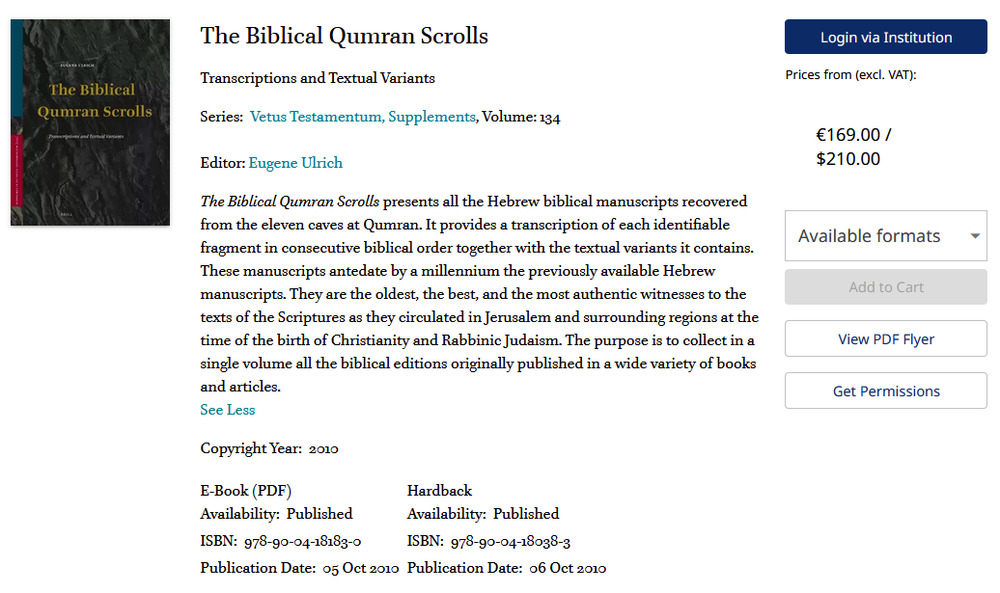> The story, all names, characters, and incidents portrayed in this text are fictitious. No identification with actual persons (living or deceased), places, buildings, and products is intended or should be inferred.
To my darling Candy,
Cymek said:
mollwollfumble said:
mollwollfumble said:
One thing I’d be very interested to know, given that Hebrew and Arabic are both Semitic languages, how easy it would be for an Arabic scholar to read transliterated old-testament Hebrew (without the diacritical marks). As easy as say an Englishman reading German or French for instance?
Hebrew is a dead language, exhumed from its grave much later. But Arabic is a living language with a consistent meaning. By Arabic scholar I mean someone fluent in Quran Arabic, which differs a bit from Classical and Modern Arabic.
> How many versions
No. How many?
It’s not fair to talk of Jewish splinter groups at the time of Jesus. During the second temple period there were the Pharisees, Sadducees and Essenes. But these were more religious denominations of equal merit than splinter groups. They differed in their interpretation of Jewish Law.
Considering only ancient versions, I did find this figure. This image is called “texts of the Old Testament”.
“Mt” here denotes the Masoretic Text; “LXX”, the original Septuagint. The rest I haven’t a clue.

Also: “The text of the Dead Sea Scrolls and Peshitta … most of the Qumran fragments can be classified as being closer to the Masoretic Text than to any other text group that has survived. According to Lawrence Schiffman, 60% can be classed as being of proto-Masoretic type, and a further 20% Qumran style with a basis in proto-Masoretic texts, compared to 5% proto-Samaritan type, 5% Septuagintal type, and 10% non-aligned.
On a different website: https://www.baslibrary.org/biblical-archaeology-review/41/3/4 starts with the beautiful classic quote:
“I want to say here and now how grateful I am to the original team of Dead Sea Scroll scholars who failed to publish the bulk of the scrolls for nearly 40 years and refused to let other scholars see them in the meantime. … “
The Dead Sea Scrolls were seriously excavated in 1948, in which year most were discovered. No new parts were discovered after the end of the 1950s.
Publication was finally done piecemeal starting in earnest in 1991 and complete in the year 2002.
“Now most of the scrolls have even been digitized and appear on the web.”
Where?
“This sudden release of texts hidden for more than four decades has had a profound effect on scholarship—of the Hebrew Bible, of Second Temple Judaism and of early Christianity.”
It has?
“What has been accomplished since 1990? … DNA … what have we learned? … evolution of the authoritative Masoretic text of the Hebrew Bible and its relation to the other textual traditions (including the Greek Septuagint) … modes of interpretation like the genre of “rewritten Bible” … we have come to understand the plurality and variety of interpretations … Disagreements about Jewish law were the main factors that separated Jewish groups … differing opinions about Jewish practice and ritual … we have been able to reconstruct the Sadducee/Zadokite Jewish laws vs the Pharisaic-rabbinic laws that is the basis for later Judaism.”
This looks tempting. Eugene Ulrich is the world authority on the biblical books among the Dead Sea Scrolls.
Previously, these had been published in serial form in Discoveries in the Judaean Desert
Volumes: 12, 14,15, 16, 17, 32, with an introduction and summary in Volume 39.
(PS. Many years ago I bought and read a copy of “The complete dead sea scrolls in English” from 1962, which turned out to be a massive disappointment because it was wildly incomplete. There was not even one of the biblical or apocrypha books in there, and the non-biblical texts were few in number and short,)

How far removed in time from being written to the actual events claimed to have taken place are the dead sea scrolls.
It depends on what you mean by “actual events”. Some scrolls do deal with actual events. The temple scroll in particular would have been written just before it was hidden. The Aramaic scrolls would have referred to very recent events. The commentaries on Jewish law, and the “modified bible” genre of stories again would have been very recent.
There’s no mention of Jesus in any of the Dead Sea scrolls.
But the Hebrew scrolls, some of them would have been ancient. Of course, of those, few if deal with “actual events”.
I didn’t realise that I don’t actually have a date for when the Dead Sea scrolls were written. Late second temple period yes, but that stretched from 200 BCE to 70 CE.
dv said:
It should be noted that David is a figure of marginally attested historicity. There are no contemporary records of his existence, though there is a reference to the House of David on a stele created maybe a hundred years after he supposedly lived.
Thanks for that.
The only thing I can add to that is that a Jewish psalm was found in Jerusalem at the time that King David was supposed to be around. But there’s no archaeological evidence whatever that David himself was ever present in Jerusalem.
The Quran does include the story of David and Goliath.
roughbarked said:
meet Francesca Stavrakopoulou | The Weekly
The real Isrelite religion | Francesca Stavrakopoulou
Doesn’t help because I don’t have any sound on this computer.
I’m still waiting for my amplifier to be fixed.
—————-
Here’s a question suitable for QI.
“What was the name of Jesus?”
Wrong answers:
Jesus, Cheeses, Cheese, Jesu, Yeshu, Yeshua, Joshua
It certainly didn’t end with an “s”, that was added later in Latin.
It was ʿĪsā, pronounced Yeesah. I’d have to get a Levantine Arab speaker to say it properly.

